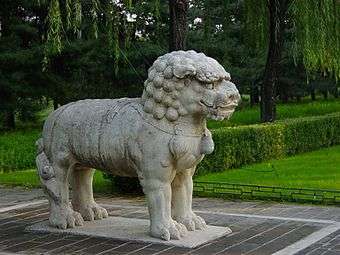Lion-Eating Poet in the Stone Den

The Lion-Eating Poet in the Stone Den (simplified Chinese: 施氏食狮史; traditional Chinese: 施氏食獅史; pinyin: Shī Shì shí shī shǐ; Pe̍h-ōe-jī: si sī si̍t sai sú; literally: "The Story of Mr. Shi Eating Lions") is a passage composed of 92 characters written in Classical Chinese by linguist and poet Yuen Ren Chao (1892–1982), in which every syllable has the sound shi when read in modern Mandarin Chinese, with only the tones differing. It is an example of a one-syllable article, a form of constrained writing possible in tonal languages such as Mandarin Chinese.
Text
《施氏食獅史》
石室詩士施氏,嗜獅,誓食十獅。
氏時時適市視獅。
十時,適十獅適市。
是時,適施氏適市。
氏視是十獅,恃矢勢,使是十獅逝世。
氏拾是十獅屍,適石室。
石室濕,氏使侍拭石室。
石室拭,氏始試食是十獅。
食時,始識是十獅屍,實十石獅屍。
試釋是事。
Explanation
Classical Chinese is a written language and is very different from spoken Chinese. Different words that have the same sound when spoken aloud will have different written forms, comparable to air and heir in English.
Many characters in the passage had distinct sounds in Middle Chinese. All the various Chinese spoken variants have over time merged and split different sounds. For example, when the same passage is read in Cantonese - even modern Cantonese - there are seven distinct syllables - ci, sai, sap, sat, sek, si, sik - in six distinct tone contours, producing 22 distinct character pronunciations. In Southern Min or Taiwanese Hokkien, there are six distinct syllables - se, si, su, sek, sip, sit – in seven distinct tone contours, producing fifteen character pronunciations.
Therefore, the passage is barely comprehensible when read aloud in modern Mandarin without context, but easier to understand when read in other dialects, such as Cantonese.
The English translation is:
Lion-Eating Poet in the Stone Den
In a stone den was a poet called Shi Shi, who was a lion addict, and had resolved to eat ten lions. He often went to the market to look for lions. At ten o’clock, ten lions had just arrived at the market. At that time, Shi had just arrived at the market. He saw those ten lions, and using his trusty arrows, caused the ten lions to die. He brought the corpses of the ten lions to the stone den. The stone den was damp. He asked his servants to wipe it. After the stone den was wiped, he tried to eat those ten lions. When he ate, he realized that these ten lions were in fact ten stone lion corpses. Try to explain this matter.[1]
See also
- Homophonic puns in Mandarin Chinese
- James while John had had had had had had had had had had had a better effect on the teacher
- Buffalo buffalo Buffalo buffalo buffalo buffalo Buffalo buffalo
- Neko no ko koneko, shishi no ko kojishi
Chinese
References
- Forsyth, Mark. (2011). The etymologicon : a circular stroll through the hidden connections of the English language. London: Icon Books. ISBN 978-1-84831-307-1.
External links
- The Three "NOTs" of Hanyu Pinyin has a similar but different text, and it explains that Yuen Ren Chao's intention was not to oppose Chinese Romanization.